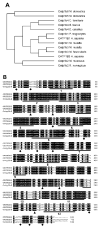Cloning/characterization of the canine organic anion transporting polypeptide 1b4 (Oatp1b4) and classification of the canine OATP/SLCO members
- PMID: 20079461
- PMCID: PMC2822128
- DOI: 10.1016/j.cbpc.2010.01.005
Cloning/characterization of the canine organic anion transporting polypeptide 1b4 (Oatp1b4) and classification of the canine OATP/SLCO members
Abstract
The human liver-specific organic anion transporting polypeptides (OATPs) 1B1 and 1B3 are involved in the elimination of numerous xenobiotics and drugs. Although dogs are frequently used for toxicologic and pharmacokinetic characterization of novel drugs, nothing is known about their OATP1B1/1B3 ortholog. Therefore, we cloned and characterized the first canine organic anion transporting polypeptide from dog liver, termed Oatp1b4. The isolated Oatp1b4 cDNA comprises 3661 base pairs (bp) with an open reading frame of 2076bp, encoding a 692-amino acid protein with a molecular mass of approximately 85kDa. The Oatp1b4 gene is approximately 61kb long and has a similar organization as the human OATP1B1 and OATP1B3 with 13 exons identical in length. Northern blot analysis shows that Oatp1b4 is predominantly expressed in the liver. Oatp1b4 mediates sodium-independent transport of typical organic anions including bromosulfophthalein (BSP), [D-penicillamine(2,5)]enkephalin (DPDPE), estradiol-17beta-glucuronide (E17betaG), estrone-3-sulfate and taurocholate. In addition, Oatp1b4 transports the OATP1B3-specific substrate cholecystokinin octapeptide (CCK-8). Kinetic studies showed that Oatp1b4-mediated E17betaG and estrone-3-sulfate transports were monophasic with K(m) values of 5+/-1microM and 33+/-4microM, respectively. In conclusion, the cloned canine Oatp1b4 will provide additional molecular basis to further characterize the species difference of the OATP1B family members.
Figures






Similar articles
-
The eighth and ninth transmembrane domains in organic anion transporting polypeptide 1B1 affect the transport kinetics of estrone-3-sulfate and estradiol-17beta-D-glucuronide.J Pharmacol Exp Ther. 2009 May;329(2):551-7. doi: 10.1124/jpet.108.148411. Epub 2009 Feb 24. J Pharmacol Exp Ther. 2009. PMID: 19244099
-
Amino acid residues in transmembrane domain 10 of organic anion transporting polypeptide 1B3 are critical for cholecystokinin octapeptide transport.Biochemistry. 2008 Sep 2;47(35):9090-7. doi: 10.1021/bi8008455. Epub 2008 Aug 9. Biochemistry. 2008. PMID: 18690707 Free PMC article.
-
Identification of a novel human organic anion transporting polypeptide as a high affinity thyroxine transporter.Mol Endocrinol. 2002 Oct;16(10):2283-96. doi: 10.1210/me.2001-0309. Mol Endocrinol. 2002. PMID: 12351693
-
Organic anion transporting polypeptides: Pharmacology, toxicology, structure, and transport mechanisms.Pharmacol Rev. 2025 Mar;77(2):100023. doi: 10.1016/j.pharmr.2024.100023. Epub 2024 Dec 9. Pharmacol Rev. 2025. PMID: 40148036 Review.
-
Clinical significance of organic anion transporting polypeptides (OATPs) in drug disposition: their roles in hepatic clearance and intestinal absorption.Biopharm Drug Dispos. 2013 Jan;34(1):45-78. doi: 10.1002/bdd.1823. Biopharm Drug Dispos. 2013. PMID: 23115084 Review.
Cited by
-
Equine Drug Transporters: A Mini-Review and Veterinary Perspective.Pharmaceutics. 2020 Nov 8;12(11):1064. doi: 10.3390/pharmaceutics12111064. Pharmaceutics. 2020. PMID: 33171593 Free PMC article. Review.
-
Cloning and Functional Characterization of Dog OCT1 and OCT2: Another Step in Exploring Species Differences in Organic Cation Transporters.Int J Mol Sci. 2022 May 4;23(9):5100. doi: 10.3390/ijms23095100. Int J Mol Sci. 2022. PMID: 35563491 Free PMC article.
-
Classification of inhibitors of hepatic organic anion transporting polypeptides (OATPs): influence of protein expression on drug-drug interactions.J Med Chem. 2012 May 24;55(10):4740-63. doi: 10.1021/jm300212s. Epub 2012 May 15. J Med Chem. 2012. PMID: 22541068 Free PMC article.
-
Interaction of Human OATP1B1 with PDZK1 Is Required for Its Trafficking to the Hepatocyte Plasma Membrane.Drug Metab Dispos. 2023 Oct;51(10):1342-1349. doi: 10.1124/dmd.123.001248. Epub 2023 Jul 13. Drug Metab Dispos. 2023. PMID: 37442606 Free PMC article.
References
-
- Abbott D, Comby P, Charuel C, Graepel P, Hanton G, Leblanc B, Lodola A, Longeart L, Paulus G, Peters C, Stadler J. Preclinical safety profile of sildenafil. Int J Impot Res. 2004;16:498–504. - PubMed
-
- Abe T, Kakyo M, Tokui T, Nakagomi R, Nishio T, Nakai D, Nomura H, Unno M, Suzuki M, Naitoh T, Matsuno S, Yawo H. Identification of a novel gene family encoding human liver-specific organic anion transporter LST-1. J Biol Chem. 1999;274:17159–17163. - PubMed
-
- Abe T, Unno M, Onogawa T, Tokui T, Kondo TN, Nakagomi R, Adachi H, Fujiwara K, Okabe M, Suzuki T, Nunoki K, Sato E, Kakyo M, Nishio T, Sugita J, Asano N, Tanemoto M, Seki M, Date F, Ono K, Kondo Y, Shiiba K, Suzuki M, Ohtani H, Shimosegawa T, Iinuma, Nagura H, Ito S, Matsuno S. LST-2, a human liver-specific organic anion transporter, determines methotrexate sensitivity in gastrointestinal cancers. Gastroenterology. 2001;120:1689–1699. - PubMed
-
- Brown KA, Bouchard N, Lussier JG, Sirois J. Down-regulation of messenger ribonucleic acid encoding an importer of sulfoconjugated steroids during human chorionic gonadotropin-induced follicular luteinization in vivo. J Steroid Biochem Mol Biol. 2007;103:10–19. - PubMed
-
- Cattori V, van Montfoort JE, Stieger B, Landmann L, Meijer DKF, Winterhalter KE, Meier PJ, Hagenbuch B. Localization of organic anion transporting polypeptide 4 (Oatp4) in rat liver and comparison of its substrate specificity with Oatp1, Oatp2 and Oatp3. Pflügers Arch. 2001;443:188–195. - PubMed
MeSH terms
Substances
Grants and funding
LinkOut - more resources
Full Text Sources

